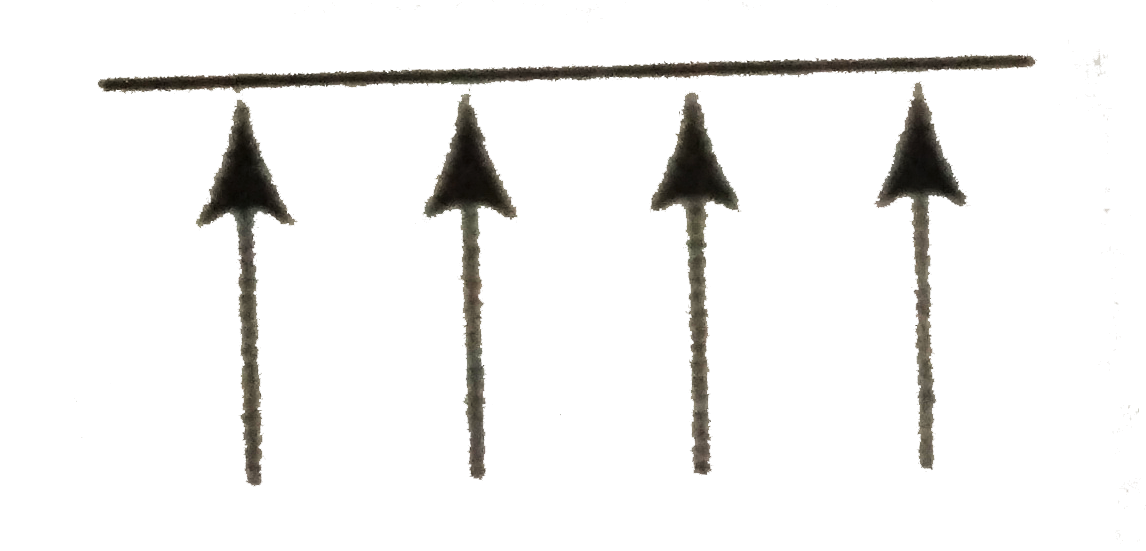What is the force exerted by a photon beam of intensity 1.4kW/m2, if it falls on a perfectly absorbing disc of radius 4 metre ?
8.35×104N
108N
8.8×10−8N
2.35×10−4N
The correct Answer is:D
The pressure exerted by a photon beam when it falls on a perfectly absorbing surface is P=IC
∴F=P×A=IC×πr2
=1.4×1033×108×(3.142)×16
=16×1.4×3.1423×10−5
=23.46×10−5=2.35×10−4N
Topper's Solved these Questions
- BOOK - MARVEL PUBLICATIONCHAPTER - ELECTRONS AND PHOTONS EXERCISE - TEST YOUR GRASP - 1715videos
ELECTRONS AND PHOTONS
- BOOK - MARVEL PUBLICATIONCHAPTER - ELECTROMAGNETIC INDUCTION AND ALTERNATING CURRENTS EXERCISE - TEST YOUR GRASP - 1630videos
ELECTROMAGNETIC INDUCTION AND ALTERNATING CURRENTS
- BOOK - MARVEL PUBLICATIONCHAPTER - ELECTROSTATICSEXERCISE - TEST YOUR GRASP20videos
ELECTROSTATICS
Similar Questions
A parallel beam of monochromatic light of frequency v is incident on a surface. Intensity of the beam is I and area of the surface is A. Find the force exerted by the light beam on the surface for following cases–
(i) the surface is perfectly absorbing and the light beam is incident normally on it.
(ii) the surface is perfectly reflecting and the light beam is incident normally.
(iii) the surface is perfectly absorbing and the light beam is incident at an angle of incidence θ.
(iv) the surface is perfectly reflecting and the light beam is incident at an angle of incidence θ.View Solution(a) A parallel beam of monochromatic light of wavelength 500 nm is incident normally on a perfectly absorbing surface. The power through any cross section of the beam is 10 W. Find
(i) the number of photons absorbed per second by the surface and
the force exerted by the lilght beam on the surface.
(a) Radiation of wavelength 200 nm, propagating in the form of a parallel beam, fall normally on a plane metallic surface. The intensity of the beam is 5 mW and its cross-sectional area is 1.0mm2. Find the pressure exerted by the radiation on the metallic surface if the radiation is completeley reflected.
(c) A parallel beam of monochromatic light of wavelength 663 nm is incident on a totally reflecting plane mirror. The angle of incidence is 60∘ and the number of photons striking the mirror per second is 1.0×1019 . Calculate the force exerted by the light beam on the mirror.
(d) A beam of white light is incident normally on a plane surface absorbing 70%) of the light and reflecting the rest. If the incident beam carries 10 W of power, find the force exerted by it on the surface.View Solution
Knowledge Check
- Question 1 - Select One
What is the force exerted by a photon of intensity 1.4kWm−2 if it falls on a perfect absorber of radius 2 m ?
A2.35×10−4 NB108NC8.35×104 ND8.8×10−8N - Question 2 - Select One
What is the force exerted by a photon of intensity 1.4kWm−2 if it falls on a perfect absorber of radius 2 m ?
A58.66×10−6NB108NC8.35×104ND8.8×10−8N - Question 3 - Select One
The amplitude of electric field in a parallel light beam of intensity 4Wm−2 is
A35.5NC−1B45.5NC−1C49.5NC−1D55.5NC−1
" of intensity "1.5kW/m^(2)" is incident normally on a perfectly absorbing surface.The pressure exerted by the light on the surface is "n times10^(-6)Pa" .Value of "n" is "
View SolutionA plate of mass 10g is in equilibrium in air due to the force exerted by a light beam on the plate. Calculate power of the beam. Assume that the plate is perfectly absorbing.
 View Solution
View SolutionWhen a beam of 10.6 eV photons of intensity 2.0W/m2 falls
on a platinum surface of area 1.0×10−4m2 and work function 5.6 eV, 0.53% of
the incident photons eject photoelectrons. Find the number of photoelectrons
emitted per second and their minimum and maximum energy (in eV). Take
1eV=1.6×10−19J.View SolutionThere is a parallel beam of light of larger aperture . Let I be the intensity of light . Perfectly reflecting sphere of radius r is kept in the path of this parallel beam . Find the force exerted by the light beam on sphere .
View SolutionAn electromagnetic wave of intensity 1400.W(m)2 falls on a metal surface of area 1.5m2 and is completely absorbed by it. Find out the force (in μN ) exerted by the beam.
View Solution

